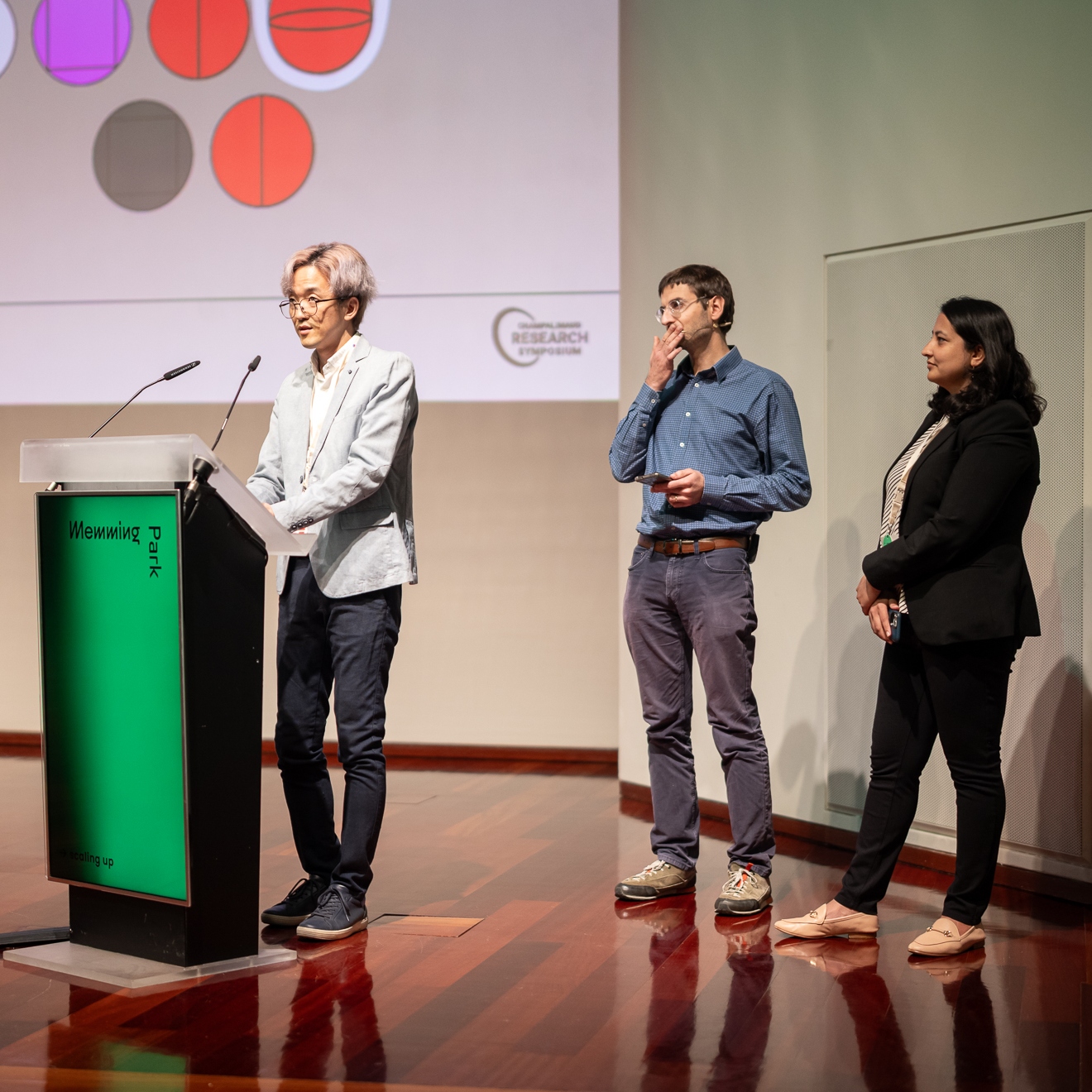With nearly 30 presenters, including four keynote speakers, and over 300 participants from across the globe, the symposium was structured into multiple sessions exploring different themes. Chaired by CF’s Memming Park, Principal Investigator of the Neural Dynamics Lab, together with Yale University’s Shreya Saxena and the University of Cambridge’s Guillaume Hennequin, the event focused on neurocybernetics – a field first defined in the 1940s that studies how brains use feedback and control to adapt, learn, and interact with their surroundings.
Keynote Talks
The symposium opened with a keynote by Misha Ahrens from the Janelia Research Campus, who revealed how his team is capturing neural activity across the entire zebrafish brain as the animals adapt in virtual worlds. By combining whole-brain imaging, connectomics, and even whole-body physiology, his group is uncovering how neurons, neuromodulators, and non-neuronal cells called astrocytes integrate experience to shape adaptive behaviour, and the ceaseless dialogue between brain and body.
The keynote talk of Adrienne Fairhall from the University of Washington, explored how the brain constantly updates its internal models of the world – the hidden calculations that help us predict, learn, and adapt to what’s happening around us. Collaborating with experimentalists across species, from hydra to mosquitoes, Fairhall’s lab uses mathematical models to study how neural systems encode information across scales, bridging single-neuron activity and whole-brain dynamics.
Eva Dyer from the University of Pennsylvania talked about training large-scale AI-models on vast collections of brain data across different tasks, brain regions, individuals, and even species. By combining many fragmented datasets into one integrated framework, her work is opening new possibilities for next-generation brain-machine interfaces and cross-species research.
Finally, Auke Ijspeert, from the Swiss Federal Technology Institute of Lausanne (EPFL), showed how robots and computer simulations can help scientists understand how animals move, from swimming lampreys to walking humans. His work reveals how the balance between spinal circuits, reflexes, and brain control has evolved across species – and how the biomechanics of the body, and feedback from the local sensors alone can synchronise swimming and walking patterns.
Selected talks and roundtable discussion
Across three days, the symposium offered a fascinating look at how behaviour arises from the continuous feedback between brains, bodies, and environments.
During Day One, speakers showed how neural activity can be organised into patterns, so-called “neural manifolds”, that help make sense of behaviour, and how new modelling tools can capture the brain’s shifting dynamics. Talks also explored how artificial “agents” that learn through feedback with their surroundings can help reveal principles of learning and adaptation, how perception itself emerges from the loop between movement and sensation, and how virtual animals and neural circuit simulations can help pinpoint the neurons essential for walking.
On Day Two, researchers discussed how sensory feedback regulates neural variability – and how the brain can even use chaos to make decisions. Other talks introduced models explaining how different neuron types shape behaviour, and how hippocampal circuits generate flexible sequences for navigation. Presentations ranged from how male fruit flies stabilise their gaze while chasing females through brain-body feedback loops, to how the brain balances fast and slow learning systems for motor adaptation: rapid neural circuits like those in the cerebellum correct errors on the fly, while slower ones gradually consolidate these changes into lasting motor memory.
On the final day, morning talks introduced a neural wristband that turns hand gestures into digital commands, as well as new AI foundation models trained on large amounts of data that can accurately predict brain activity without retraining. A panel discussion on “The Future of Neurocybernetics” asked how researchers can best work together to understand behaviour at scale. The afternoon returned to brain-body interactions – from simulating a fruit fly’s whole body and brain to understand how behaviour is generated, to using immersive virtual environments to explore the interplay between neural circuits, movement and emotion during real-world decision-making in the human brain.
Reflections
Drawing inspiration from recent breakthroughs in AI, the symposium’s organisers believe neuroscience may be approaching a similar inflection point – one in which scaling, feedback, the integration of diverse datasets, and closer collaboration across disciplines could unlock new levels of understanding.
As Symposium co-Chair Memming Park reflected: “What made this symposium special was that it reminded us where the real frontier lies. The field has been pulled in many directions by the rise of AI – sometimes in ways that forget our deeper traditions of control, embodiment, dynamics, and the fine beauty of biological systems. But those ideas were never outdated; they were simply waiting for the right moment to be synthesised at scale. What we saw here was a kind of reunion between neuroscience and engineering: to understand behaviour, we need to think about the many nested feedback loops connecting the brain, body, and environment”.
“It was really exciting to see so many different corners of science – motor control, locomotion, connectomics, robotics, machine learning, and dynamics – all beginning to align under the umbrella of neurocybernetics. You could feel that these ideas wanted to intermix, collide, and synergise. I think we made a real course correction, setting a new collective direction for the field. The feedback was so positive that we might have to do this again soon!”.
The Champalimaud Foundation extends its gratitude to all the speakers, participants, sponsors and organisers who made CRSy25 possible
Text by Hedi Young, Science Writer and Content Developer of the Champalimaud Foundation's Communication, Events & Outreach Team

